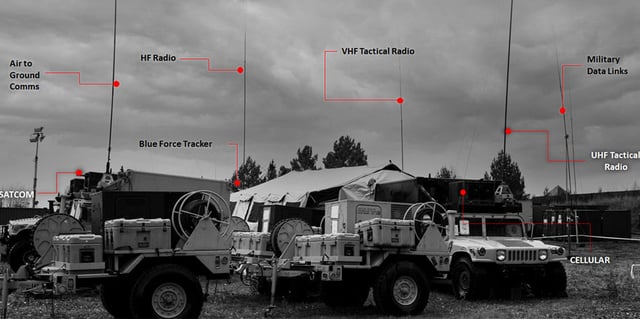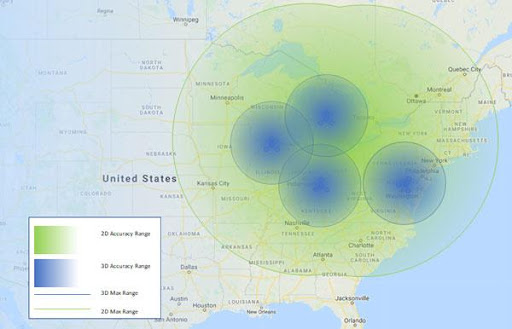4 Reasons your military installation needs agile spectrum monitoring tools

Spectrum management at many military installations was chiefly a database exercise involving lists of approved frequencies, users, times, and locations that operated on a “trust system.” These administrative burdens shackled spectrum managers, who spent hours approving frequency requests, users, times, and locations. Real-time monitoring was a low priority for most military ranges and bases.
But not anymore. Today, there are ever more new and growing threats. So, spectrum managers recognize the need for comprehensive and proactive methods to carry out 24/7/365 comprehensive and proactive spectrum operations for both tactical and operational reasons. Doing so lets them maintain appropriate situational awareness to react to unpredictable situations, detect and mitigate jamming, and prevent potential RF collisions.
Here we share the views of four spectrum managers and the cases they put forward for prioritized investment.
1. Know exactly what is happening in the RF spectrum
With so many different types of equipment—both civilian and military—it isn’t enough for military installations to only have a list of the types of authorized transmissions. Active 24/7 monitoring is a must. Jamming and interference don’t work 9-5. Installations need the ability to capture and record RF transmissions to submit timely and accurate interference reports (like the US DOD Joint Spectrum Interference Report or JSIR).
If base personnel broadcast on the wrong frequency, at the wrong time, or in the wrong location, it needs to be flagged immediately and mitigated. Similarly, accidental interference experienced by base personnel (either from other installation users or civilians) must be immediately detected and the source geolocated before it becomes an issue—not to mention hostile or deliberate jamming from an enemy force. Being able to determine the source of jamming or interference is the center point for spectrum managers.
Before the introduction of today’s powerful spectrum monitoring tools, spectrum managers relied on bulky handheld spectrum analyzers to locate the source of a signal. Personnel had to manually retrieve and deploy the spectrum analysis device and locate the signal due to issues with the device’s range and coverage. With bases as large as small cities, driving from the spectrum manager's office to the reported location of interference could take hours.
Not only does this old approach waste a lot of valuable time and resources, but it’s easy to miss a low-power, intermittent or pulsing signal, or one moving quickly. Without persistent spectrum monitoring, the base is effectively in the dark.
2. Deliver force protection and spectrum dominance
Continuous, persistent spectrum monitoring is the only way to protect a military installation from unauthorized RF activity. Whether the RF signal is from a drone or unmanned aerial vehicle incursion, deliberate jamming, spoofing, surveillance balloons, or something else that shouldn’t be there, you can instantly detect it and take appropriate steps to neutralize threats (even during off hours, holidays, and weekends).
Using powerful spectrum monitoring tools for Force Protection as another first alert sensor is an additional way of alerting base security personnel. As one spectrum manager put it, “You wouldn’t be asked to control the skies without radar. So why would you want to operate and safeguard spectrum operations without 24/7/365 spectrum monitoring?”
Additionally, base commanders need to know that they can always maintain freedom of maneuver—or deny that freedom to adversaries. Commanders wrongfully assume RF spectrum dominance, but they can only achieve it if they have an accurate picture of the RF environment. Knowing, in real-time, what transmissions are friendly, civilian, or potentially hostile feeds into operational planning and ensures spectrum dominance is maintained—critical in multi-domain operations.
As one spectrum manager put it, a spy balloon drifts overhead, and the base commander is asking, “Is the electromagnetic environment compromised? Can we move personnel in the usual way and communicate without risk and fear of jamming or RF interference? Can we deploy freely and effectively?” With real-time spectrum monitoring, the spectrum manager will have these answers.
3. Report on your actual spectrum usage and occupancy
The RF spectrum is a finite resource, and there are many demands on it from both civilian and military users. This creates a use-it-or-lose-it scenario for many base commanders.
And, with so much demand for civilian uses ranging from delivery drones to critical civilian communications, there are always questions about if and when portions of military spectrum bands should be shifted into the civilian domain.
However, if such a shift were to occur, it could present many challenges to base commanders in terms of cost, disruption of service and operations, and degradation to existing military infrastructures. Base commanders need to have the data to support their spectrum use within that band. Without them, it will be difficult to justify keeping the allocation.
Real-time and schedulable spectrum monitoring tools make that data readily available and easy to search and sort. Moreover, they provide detailed reports of spectrum occupancy over a sustained time period.
4. Join other installations to create a wide area intelligence network
There are sometimes not enough spectrum managers, and this problem compounds during crisis situations when military forces forward-deploy and create additional forward operating bases and airfields. Today’s industry-leading tools can be networked with other installations and their spectrum monitoring solution to provide a wider picture of the RF spectrum across the theater. This larger picture is indispensable for operational and strategic decision makers on joint and allies staffs.

Figure 1: Simulated example of a possible interlinked spectrum monitoring network that combines multiple bases into theater-level coverage.
As forces flow between bases and across the theater, having a larger view of spectrum usage and trends can influence the strategic decision-making process up to the general/flag level. This could be a major gap in operational-level spectrum management and Joint Electromagnetic Spectrum Operations Cell (JEMSOC) staffs.
Conclusion – dominate your RF spectrum
It's irrelevant if your base is located within your home country or abroad; limited handheld spectrum analyzers are no longer enough to operate day and night within a crowded and contested spectrum.
Military installations are investing in real-time spectrum monitoring tools to understand the RF environment in which they operate, maintain frontline readiness, preserve spectrum dominance, and have the information they need to respond to a challenge or threat at a moment’s notice—without compromise or delay.
Zac George
Zac George is the International Business Development Manager for CRFS. He is a former naval Electronic Warfare officer and also has experience in digital decoding. He speaks regularly on EW and spectrum topics globally, and lives in Switzerland.
